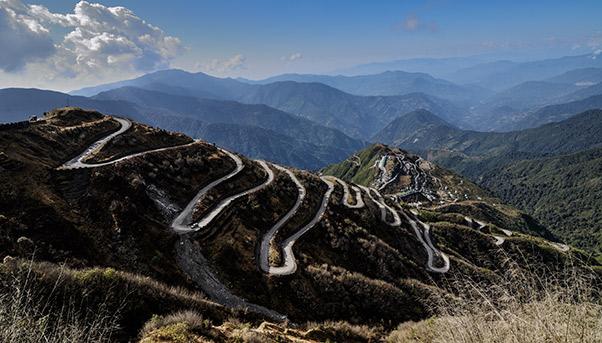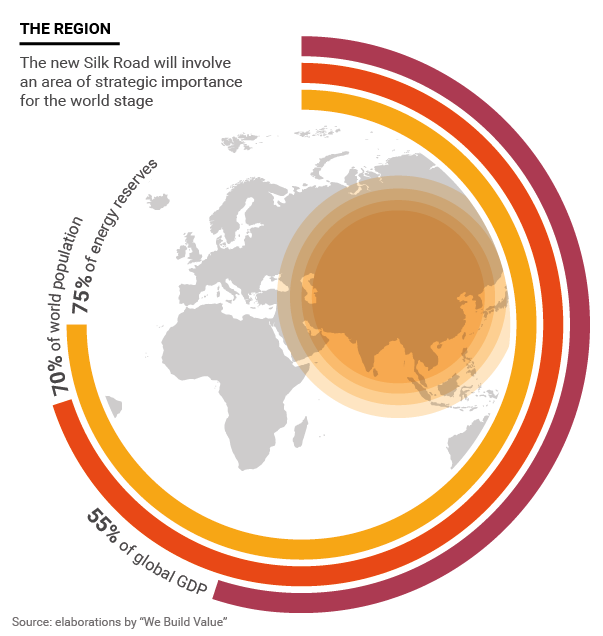
The Silk Road is becoming relevant again, with Italians making their presence known just like they had in the times of Marco Polo when one had to leave from the port of Tana at the mouth of the Don River on the Sea of Azov at the extreme end of the Black Sea in order to reach Cathay, as China was once called. But not before crossing Central Asia. The maritime city of Hangzhou near Shanghai was the first point of entry, and from there one would arrive in Beijing. Estimated time: less than 300 days.
Making an appearance along the ancient route of the Silk Road in these modern times is the Italian Group Salini Impregilo, which is completing the final stretch of nearly 300 kilometres of road in Kazakhstan, from the city of Almaty to Khorgos at the Chinese border. The entire project involved expanding and modernizing 630 kilometres of road for €530 million. Work will soon be completed. Today, as in the time of Marco Polo, the routes to take from the Mediterranean to China can vary. One can choose the maritime route through the Suez Canal, which is the cheapest but also the longest, taking nearly 50 days. Or one can go by rail with the Trans-Siberian. Goods take two weeks to reach Beijing but at a higher cost.
The new link by land will reduce the travel time to Beijing to a dozen days at a cost that is competitive. It is to be expected that this project will also benefit the countries crossed by this new route. In Kazakhstan, the four-lane highway has brought a 60% increase in the traffic of merchandise compared with the previous year.

The new Silk Road covers an area where 70% of the world’s population lives, is responsible for 55% of the world’s gross domestic product and possesses 75% of known energy reserves. So it is understandable that there is more than one person who is looking with interest at the progress of this project. The Chinese government believes wholeheartedly in it, embarking on its “One Belt, One Road” initiative in 2013 to revive this ancient and glorious commercial route. The newly created Asian Infrastructure Investment Bank – strongly favored by Beijing – will invest an initial $100 billion in it. The first loans should be given out in the first half of 2016. The multilateral bank has 57 member countries, including Italy with a 2.6% stake. Russia has been less enthusiastic about the whole thing, given its rapport with the European Union. This has led to a slowdown in the work on its territory, consisting of 2,233 of 8,445 kilometres that are needed to reach the port of Saint Petersburg. The work is expected to be finished by 2020.
Kazakhstan , meanwhile, is trying to finish the job as soon as possible. But even it has had to slow things down because of the drop in the price of oil and the resulting drop in income for the big Central Asian country. But the government in Astana has decided to go ahead in any case. So, by next year, the country will be linked to the
Persian Gulf and be able to increase in a significant way its grain exports to Iran. The Kazakh part of the new Silk Road is 2,787 kilometres and involves an investment of $75 billion. It will be a four-lane highway that will allow for speeds of 120 kilometres per hour. A big chunk of the route in Kazakhstan dates back to the Soviet times. It has not been renovated since then, causing an infrastructure crisis throughout this vast territory. Its poor state has led to a rise in traffic accidents. But things are changing. During the 2016-2018 period, $14 billion in financing has been dedicated to infrastructure. The Silk Road is the most important part of the country’s network of roads, and Kazakh President Nursultan Nazarbayev has announced his aim to increase the traffic of goods along this artery up to 30 million tons a year.
There is also part of the new Silk Road that is on rail. In 2015, the port of Rotterdam received the first containers brought by train from China. The 10,800 kilometres of rail that unite Chongqing and Duisburg in Germany allow for Hewlett Packard to connect its European clients with Chinese factories, for example. On their return to China, the containers are loaded with European luxury cars for the gigantic Asian market. But things are not that simple because there are some 40 countries involved and the trains must change two times because of the different gauge of the railways in Russian, Byelorussia, Mongolia and Kazakhstan in comparison with China and Europe. This is one reason why the highway could be seen to be quicker in addition to being 2,400 kilometres shorter. So a lot of headway has been made since the time of Marco Polo when it took 300 days to reach China from Europe.

